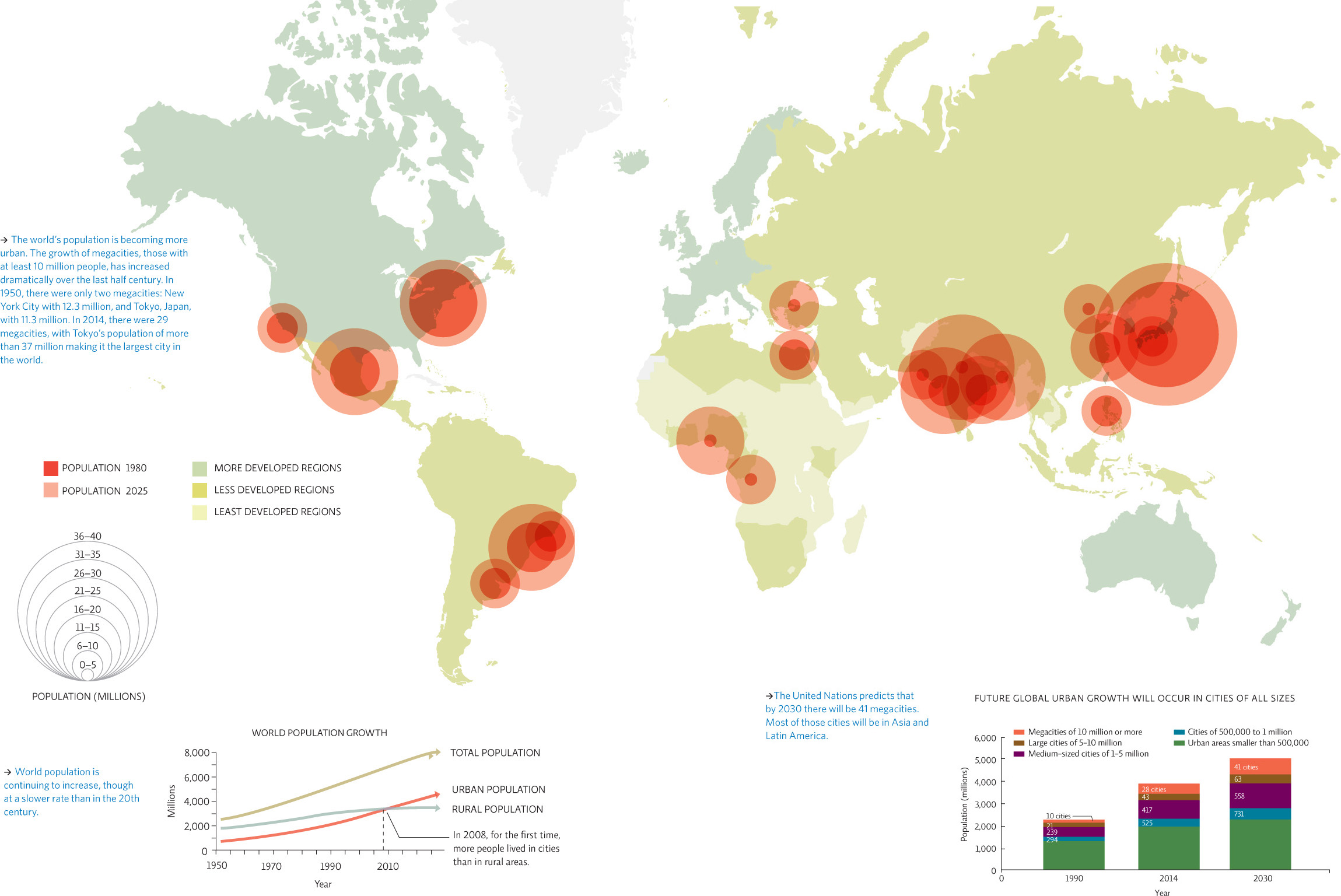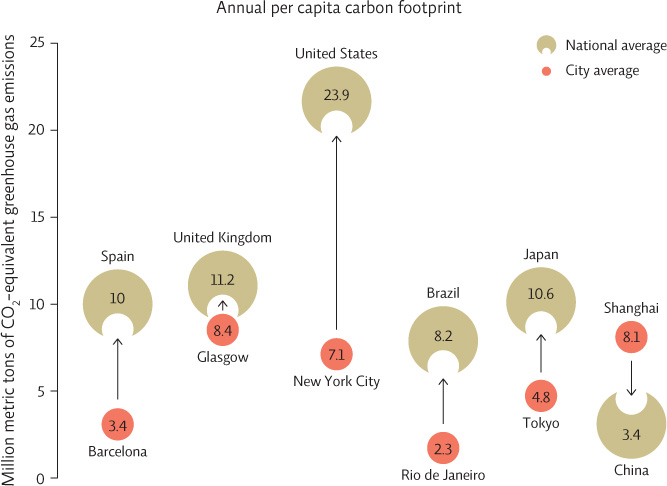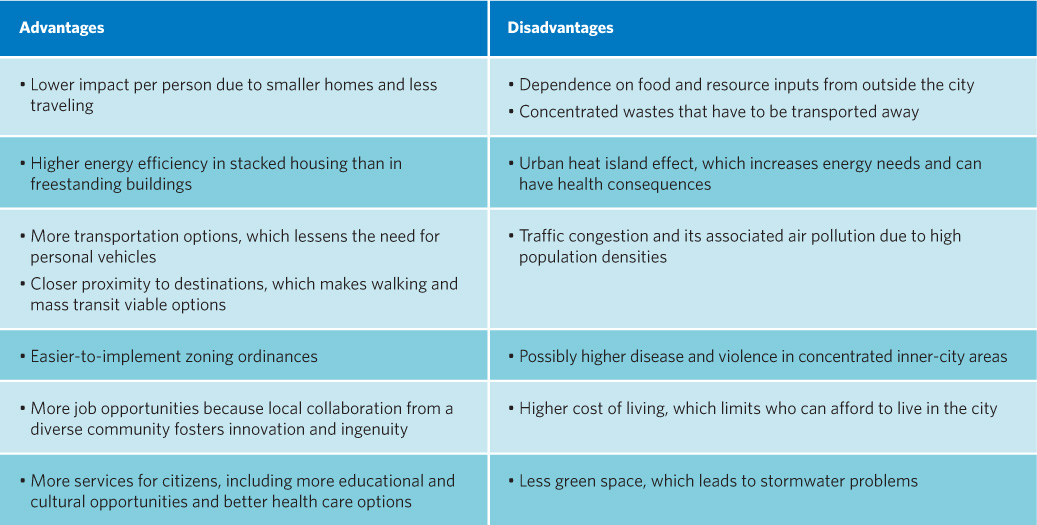More people live in cities than ever before.
For the first time in human history, more than half the world’s population lives in urban areas—densely populated regions that include both cities and the suburbs that invariably surround them. In the United States the proportion is even higher: 80% of Americans are urban dwellers. Urbanization, the migration of people to large cities, is happening around the world at an unprecedented rate. As global population swells, rural lands are morphing into urban and suburban ones, and ordinary cities are growing into megacities—those with at least 10 million residents. With more than 19 million inhabitants, the New York City metropolitan area qualifies as the largest city in the United States and one of the world’s 29 megacities. INFOGRAPHIC 25.1
urban areas
Densely populated regions that include cities and the suburbs that surround them.
urbanization
The migration of people to large cities; sometimes also defined as the growth of urban areas.


What are the advantages and disadvantages of living in a megacity?
Large cities may have more services, jobs, cultural and educational opportunities, and better health care but it is likely that these benefits are not available to all residents. Megacities are also likely to have more pollution, more crowding, and more problems with waste. Crime may also be high.

KEY CONCEPT 25.1
As of 2008, more people live in cities than in rural areas. The number of megacities has greatly increased since 1950 and will continue to do so in the future.
To be sure, cities bring some obvious advantages to their inhabitants: more job opportunities, better access to education and health care, and more cultural amenities, to name a few. But as far as the environment is concerned, urbanization is both a blessing and a curse. On the plus side, concentrating people in smaller areas (building up rather than out) can reduce the development of outlying agricultural land and wild spaces and thus protect existing farms and ecosystems. Higher population densities also make some environmentally friendly practices more cost-effective. For example, it’s easier to implement recycling and mass transit programs in cities because there are more people to share the costs of these services. Living in smaller homes that are closer to needed amenities and having access to mass transit also decreases the energy use—and the carbon footprint—of urban dwellers compared to those who live in suburban areas. INFOGRAPHIC 25.2
Due to higher population densities, less personal vehicle travel, smaller homes, and efficiencies of scale, people living in large urban areas typically have a lower ecological footprint than those in suburban areas. A 2009 study by geographer David Dodman compared the carbon footprints of various countries and large cities within those countries. Almost all of the cities evaluated had lower carbon footprints than their national average.


According to this data, only Shanghai has a carbon footprint higher than the national average. Why do you think this is true for Shanghai but not the other cities evaluated?
Shanghai is an urban center in a very large country with a large low-income, rural population. This brings the national average down. But it is interesting to note that Shanghai's footprint is lower than the national footprint of all the other countries.
For the first time in human history, more than half the world’s population lives in urban areas.
On the minus side, cities are locally unsustainable: They require the import of resources like food and energy and the export of waste. Because they are densely populated, most cities are also hotbeds of traffic congestion (which pollutes the air) and sewage overflow (which pollutes the water).
Another problem stems from the way cities are designed and built—namely, the replacement of vegetation with pavement. Plants absorb water, filter air, and regulate area temperatures; pavement and concrete do not. In fact, the blacktop that covers most cities prevents rainwater from being absorbed into the ground, which in turn diminishes groundwater supplies and can lead to flooding (see Chapter 15). Cities also require an abundance of energy. This trifecta—too few plants, too much pavement, and high energy use—conspires to trap solar heat absorbed, and put off, by buildings, making most cities warmer than their surrounding countrysides. This phenomenon is known as the urban heat island effect. TABLE 25.1
urban heat island effect
The phenomenon in which urban areas are warmer than the surrounding countryside due to pavement, dark surfaces, closed-in spaces, and high energy use.


How might the disadvantages of urbanization be addressed to lessen their impact?
Wastes: Programs and incentives to reduce the generation of waste (the 4 Rs; higher cost to discard waste); Urban heat island effect: More green spaces; Food and resource inputs: community gardens and resource use reduction programs (i.e. more efficient building designs and reclaiming old building material); Disease and violence: social programs to improve health, jobs, encourage community identity (community watch programs, community pride); Traffic congestion: suitable transit options, fee driven permits required to drive in inner city areas; Less green space: increase greenspace, especially where stormwater flow is a problem.
All urban dwellers are vulnerable to the health effects associated with pollutants. But in most cities, the pros and cons of city living are unevenly realized. For example, New York City is one of the wealthiest, most populous cities in the world, but most of the cultural amenities, top-notch health care facilities, and job opportunities are concentrated in Manhattan, while most of the garbage, sewage, and power plants are located in the Bronx. This imbalance has spawned a whole new area of activism known as environmental justice, based on the idea that no community should be saddled with more environmental burdens and fewer environmental benefits than any other.
environmental justice
The concept that access to a clean, healthy environment is a basic human right.
KEY CONCEPT 25.2
Cities offer many services and opportunities and a lower per capita ecological footprint than other areas but have problems with waste, stormwater, and higher rates of crime and disease.
The movement is particularly relevant in the most impoverished cities in the world. In Mumbai, the largest city in India, with 20.5 million people, almost 7 million are slum dwellers who live in horrid, overcrowded conditions—as many as 18,000 people per acre—without adequate sanitation or running water. One report showed only one toilet per 1,440 residents. Globally, more than 1 billion of the world’s population live in slums, mostly in large cities in developing countries.
With 90% of future population growth predicted to occur in large cities, urban planners are desperately searching for ways to create cities where the basic needs of residents are met and where the environmental benefits outweigh the environmental costs. The story of how the South Bronx waterfront was lost and then reclaimed provides important lessons about how to do this.